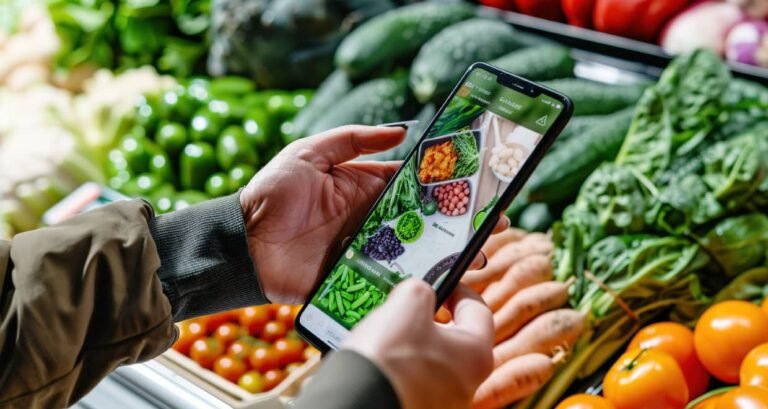Technology-driven innovation is the main force behind the food trends that will shape the health industry in 2025.
We take a close look at the transformative trends shaping the food industry in the coming year as the industry moves towards more innovative and sustainable practices.
#1. AI-driven nutrition information and recommendations
When we access advances in artificial intelligence (AI), harness unlimited potential to understand how DNA influences our ideal diet while accessing personalized recommendations based on the vast and growing body of research available on diet for weight loss or improved health and wellness.
By leveraging genetic testing, AI systems can identify specific genetic markers that affect how the body metabolizes nutrients and use that information to develop personalized meal plans that optimize nutritional consumption based on genetic predispositions.
But it’s not just at the confluence of AI and DNA where technology can support our dieting efforts. A recent study1 published in the journal Nutrients thoroughly explored the current landscape of artificial intelligence in nutrition and provided a deep understanding of the potential of artificial intelligence, machine learning (ML) and deep learning (DL) in the nutrition sciences.
Meta-analysis identified several AI applications in nutrition, covering smart and personalized nutrition, nutritional assessments, food identification and tracking, predictive modeling for disease prevention, and disease diagnosis and monitoring.
According to the study, the selected studies “demonstrated the versatility of machine learning and deep learning techniques in handling complex relationships within nutrition datasets” and concluded that “with the rapid advancement of artificial intelligence, the incorporating it into the diet promises to significantly enhance individual nutritional results and optimize nutritional recommendations.”
For example, AI-powered apps and tools make it easier than ever to track your macros and overall nutrient intakeoffering immediate feedback on dietary decisions in addition to accurate information on the nutritional value of meals. These apps and platforms can then provide healthier recommendations and track progress toward your goal.
#2. Personalized nutrition
Personalized nutrition (sometimes referred to as precision nutrition) continues to emerge as a nutrition trend driven by advances in genetic testing.
Because of genetically determined individual differences in our responses to specific diets and food groups, people increasingly understand that there is no one-size-fits-all approach to nutrition.
As a result, more people are seeking customized nutritional plans based on DNA, microbiomes, activity levels, lifestyle factors, and specific health and wellness needs.
The recent explosion in genetic knowledge has revealed new connections between genes and how our bodies digest, process, absorb and use specific nutrients, which affect our weight and health.
To achieve your weight loss and wellness potential, we must make lifestyle choices that match our unique genetic makeup, with DNA testing a fundamental tool that can help us make more accurate choices.
Commonly known as nutritional genetics, this branch of dietetics deals with the effects of our individual genetic variations in response to our diet and other sources of nutrients.
#3. Alternative proteins
Traditional protein for human consumption comes from meat, fish, dairy products and eggs, with meat production one of the most resource-intensive forms of farming, requiring significant land, water and energy.
Also has an excessive environmental impact due to greenhouse gas emissions and the use of arable agricultural land, with data from the University of Colorado Boulder Center for the Environment showing that raising animals for human consumption generates nearly 15% of total global greenhouse gas emissions. Additionally, processing one pound (0.45 kg) of beef uses 2,500 gallons (9,500 L) of water, while it takes 477 gallons (1,805 L) of water for eggs and nearly 900 gallons (3,400 L) for cheese.
Sainsbury’s Future of Food Report therefore explains how scientists are calling for a change in our diet and the way we consume our protein, with expectations that the market for non-traditional or alternative proteins will grow more than 25% by 2025.
Key trends in this space highlighted in the report include jackfruit, mushroom-based products, seaweed milk, seaweed caviar and insect protein.
#4. Planet friendly food
According to the latest Sainsbury’s Future of Food report, people today care about more than what we eat.
We also want to know how it is grown, produced, packaged, transported and soldas these factors have implications “not only for human health, but for natural habitats, animal life and biodiversity, for water consumption and desertification, for soil fertility and eutrophication, for pollution and greenhouse gases”.
Therefore, planet-friendly food and food production continues to grow as a production trend in the food industry.
The report describes how retailers are playing an important role in increasing public awareness of how food systems affect the environment and giving consumers choices to do their part to support sustainability and a healthier environment through their food choices .
“According to scientists, Diet is the single biggest way for humans to reduce their environmental impacteven more than how they travel,” the report says.
“Eating a more plant-rich diet helps reduce excess nutrient runoff from agricultural areas into rivers and lakes, land and water use, and greenhouse gases. Currently, more of us are looking to eat seasonally and more fresh produce. With fewer food miles, the promised freshness and even the chance to know who has grown your food, seasonally and locally can offer a low environmental impact and support local economies (especially when renewable energy is used for production).
References:
- Theodore Armand TP, Nfor KA, Kim JI, Kim HC. Applications of Artificial Intelligence, Machine Learning and Deep Learning in Nutrition: A Systematic Review. Nutrients. 2024 Apr 6; 16(7): 1073. doi: 10.3390/nu16071073. PMID: 38613106; PMCID: PMC11013624.
Author: Pedro van Gaalen
When he’s not writing about sports or health and fitness, Pedro is most likely out training for his next marathon or ultramarathon. She has worked as a fitness professional and as a marketing and comms specialist. He now combines his passions in his role as managing editor at Fitness magazine.
